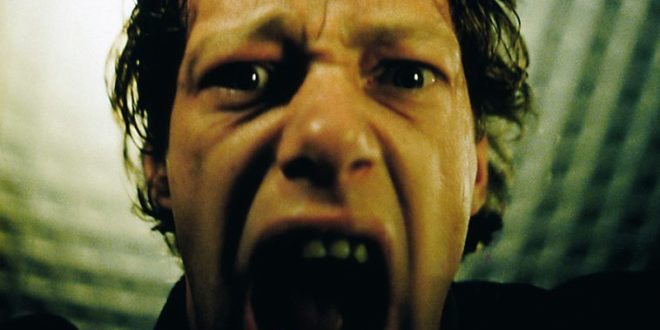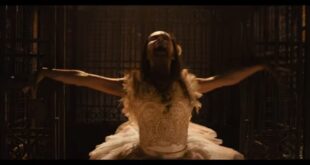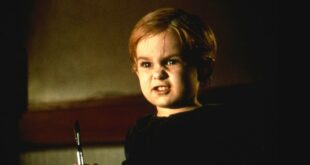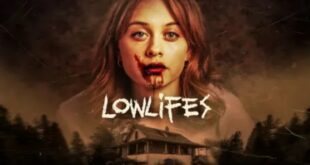In 1983, Austrian director Gerald Kargl unleashed his first (and, to date, only) feature-length film. The film shocked Austrian moviegoers. A scandal followed. After playing movie theaters for a week, it was pulled and played only in a few porn theaters. Pending release in America, the film was slapped with a XXX-rating and the distributor pulled out. The film was never widely-distributed on video, thus making it one of the most sought-after items on the bootleg circuit – until now that is. That film is Angst.
https://www.youtube.com/watch?v=az6V22WNayY
The Werner Kniesek Case
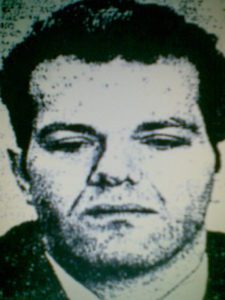
Angst is based on the true story of Austrian serial killer, Werner Kniesek. In 1963 at age sixteen, Kniesek stabbed his own mother ten times while saying, “Mommy, you must die now, nothing will help you now.” His mother survived the assault and Kniesek was sentenced to two to four years in prison for attempted murder.
Nine years later, in 1973, Kniesek came to the house of a 73-year-old old age pensioner, Margarete Müller, and knocked on her door. When she answered, Kniesek said, “I’m shooting now,” and shot her twice in the stomach. She survived. Kniesek was apprehended the next day. A terrible heat wave was blamed for his actions. Nevertheless, Kniesek was sentenced to seven-and-a-half years in prison.
Upon release in 1980, Kniesek broke into the house of Gertrude Altreiter (56), which she shared with her mentally-disabled son, Walter (27), and her daughter Ingrid (25). There, he strangled the three out of “pure lust for murder.” At one point Kniesek gave Gertrude medication so she would live longer. After killing them, Kniesek packed the bodies into the family’s Mercedes and drove to the Austrian city of Salzburg, where he was arrested.
During the trial, discussion of reinstating the death penalty came up. In the end, Kniesek was sentenced to life in prison. In 1983, during the filming of Angst, Kniesek attempted to escape during a medical check-up using a replica pistol. The attempt was thwarted. Kniesek is still alive and currently serving out his life sentence.
The Making of Angst
Director Gerald Kargl stated that his interest in Kniesek’s psychology was the impetus for the film. Kargl “wanted to provide a deep look inside a deranged psyche via mainly real-time narration and his inner voice.” Kargl teamed with Oscar-winning Polish filmmaker Zbigniew Rydczynski (1983: Best Animated Short, Tango), who provided the film’s excellent cinematography. The film was financed by Kargl with his credit cards, bringing the film’s budget to 400,000 Euro (447,939 in American dollars). During filming, the entire cast and crew lived together in the villa during which the last half of the movie takes place. This was done for organizational reasons.
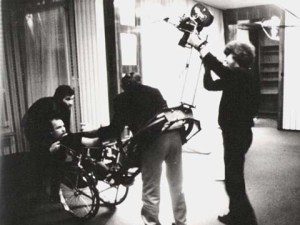
Erwin Leder (Das Boot, Schindler’s List) was brought on board to play The Psychopath. Leder grew up in a psychiatric institution where his parents worked. Leder was fascinated by “the portrayal of the obsessive-compulsive neurosis of the character, the demonstration of his hopelessness, his instinctive obsessiveness and all in all courting the audience’s empathy.” Silvia Rabenreither (The Daughter) states that Leder “was super dedicated and totally absorbed in his role.” Leder even went so far as to actually vomit in one scene; in another, be breaks a real pane of glass, an act which hurt his hand.
As can be seen upon viewing, Angst is a very technical picture laced with hand-held camerawork, crane shots, high and low angles, and mirrored shots. Rydczynski’s camerawork is definitely the best aspect of the film and contains more style than than most directors’ oeuvre . In fact, the breathtaking crane shot near the beginning – in which the camera pans over the rooftops of the prison before going down to the street to meet The Psychopath just as he exits the prison gates – is one of the most astounding camera shots ever committed to film. Shots of this caliber mix with close-ups of Leder. In these latter shots, the external world is a bit out of focus which helps trap viewers within The Psychopath’s world. These varying camera techniques lend the film feelings of both clinical detachment and personal involvement.
Klaus Schulze of Tangerine Dream provided the music for Angst. The soundtrack is more well-known than the film itself. One track, “Freeze,” was featured in Michael Mann’s 1986 film, Manhunter. While the soundtrack contains six tracks, most of them aren’t heard in the film. Only “Surrender” is heard regularly to great effect. This cold, dance-like number creates mixed feelings in the audience: should we be dancing, or should we be looking over our shoulder for a crazed psychopath?
The Movie
Angst follows a killer known only as The Psychopath (Erwin Leder) on his first day of freedom from prison. Instead of trying to rebuild his life, he sets about finding fresh victims. After a failed attempt to strangle a female taxi driver, The Psychopath roams the Austrian countryside until he stumbles upon a house populated by a mother, daughter, and disabled son. For them, the nightmare is just beginning…
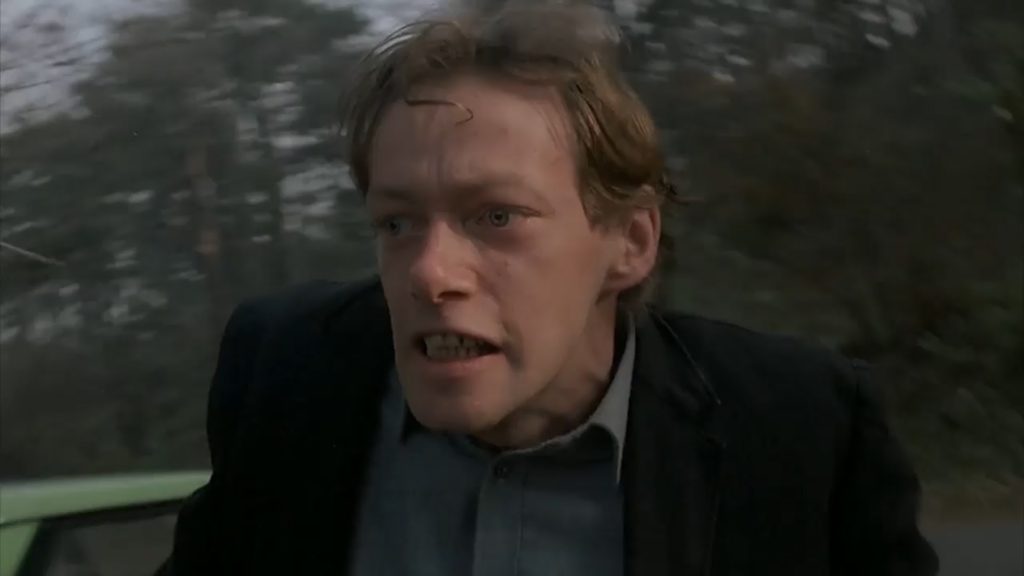
Angst is one of the greatest, if not the greatest, serial killer films ever made. While Henry: Portrait of a Serial Killer has a gritty look and tone that definitely puts it high on the list, it lacks the feel of Angst. Angst is not a film you watch, but experience.
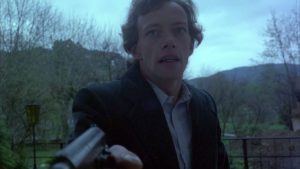
Erwin Leder’s commitment to the role of The Psychopath shines through as one of the best presentations of a psycho ever committed to celluloid. It takes great acting to be able to hold attention during what is fundamentally a one-person drama, and Leder pulls it off remarkably well. His performance is an exercise in perfectly-controlled extremism and keeps the character grounded in reality. With his wild-eyed look and nervous movements, you get the feeling that Leder is legitimately psychotic and completely helpless against the violent and destructive forces that move him, almost like he is a mere pawn in a game played by some transcendent and evil entity.
But he is also not completely evil: despite killing the entire family, The Psychopath leaves their Dachshund alone. In fact, he takes it with him during his escape. Not only that, he later feeds the dog a bratwurst shortly before his capture. Despite the total feeling of nihilistic despair the film is going for, the scenes of The Psychopath walking about the villa with the dog following happily along will provoke a mild smirk from the viewer.
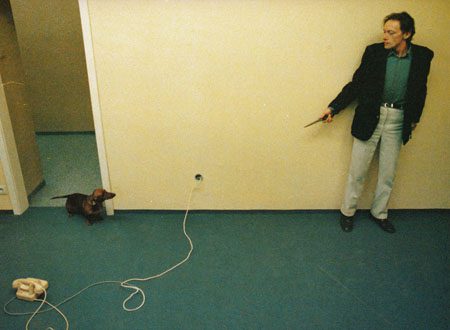
While the murders and acts of violence are mostly bloodless, they have a brutality about them unmatched by any other film of this sort. The scene in which The Psychopath attempts to resuscitate The Mother by cramming pills down her throat is positively disturbing. The death of the mentally-handicapped son, who refers to The Psychopath as “Papa,” is enough to make even the most hardened of hearts spasm with sympathy.
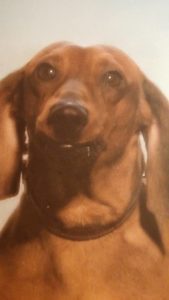
The only real bloody moment in the film comes at the end when The Psychopath overtakes the fleeing daughter in the film’s infamous tunnel scene. The previous scenes of murder, while brutal, have a subdued quality about them. Here, The Psychopath goes for broke as he brutally stabs the victim (the splashing blood covers the floor, walls and himself), defiles her corpse, then drinks her blood which leads. It is during this scene that a shot of the Dachshund pops up. The dog is overlooking the proceedings and appears to be smiling, almost as if it approves of The Psychopath’s behavior (shades of Son of Sam perhaps?).
During the entire film, we are given a look at The Psychopath’s thought process from the monologue provided by Robert Hunger-Bühler. The monologue includes quotes from the confessions of real-life serial killers such a Peter Kürten, the “Vampire of Düsseldorf.” These monologues not only give us a look into a disturbed mind, but they also fill out some biographical details (which are also disclosed in the 8-minute “Prologue” of the international cut).
Release and Aftermath

The release of Angst was met with controversy. It opened in major theaters, played for about a week, then disappeared. Reports of people throwing up during viewings and demanding their money back were common. According to Rabenreither, the film played in a porn theater at one point. Angst was central to discussions about violence on the screen: did viewing such things make people more violent? Or was it their violent tendencies which made them watch these kinds of movies?
While Angst did receive some critical acclaim, the film was a financial flop. As a result, Kargl began directing TV commercials in order to pay off his debts. He has yet to make another feature film.
The film didn’t fare much better abroad. Kargl: “In France it was available on a VHS-tape called Schizophrenia and it became a cult movie. In Britain and Germany some labels were interested but it would have been banned for violent content. Therefore it never came out there… In the USA the film was rated XXX, which marked it as ‘pornographical’ [sic], therefore the distributor stepped back.”
Re-Release
For years, the only way to view Angst was via pirated copies. Eventually, a German DVD was released on June 1, 2006. However, this version didn’t include the 8-minute prologue and the tunnel sequence was darkened by Kargl to conceal some of the violence, which he thought was too over-the-top.
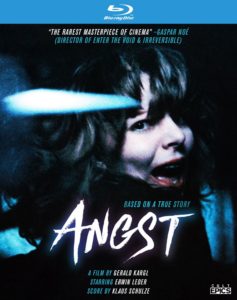 Angst didn’t see an official American DVD/Blu-ray release until 2015 thanks to Nico B. and his company Cult Epics. The release contains both Kargl’s cut and the international cut of the film. Also, the tunnel sequence has been restored to its original state. A 40-page booklet is included with information about the film; interviews with Kargle, Leder, and Rabenreither; as well as newspaper clippings detailing the Kneisek case. Special features include an interview with Erwin Leder, an interview with Zbigniew Rybczynski, an interview with Gerald Kargl conducted by Jörg Buttgeriet (Nekromantik), an introduction by Gaspar Noé and audio commentary with Gerald Kargl.
Angst didn’t see an official American DVD/Blu-ray release until 2015 thanks to Nico B. and his company Cult Epics. The release contains both Kargl’s cut and the international cut of the film. Also, the tunnel sequence has been restored to its original state. A 40-page booklet is included with information about the film; interviews with Kargle, Leder, and Rabenreither; as well as newspaper clippings detailing the Kneisek case. Special features include an interview with Erwin Leder, an interview with Zbigniew Rybczynski, an interview with Gerald Kargl conducted by Jörg Buttgeriet (Nekromantik), an introduction by Gaspar Noé and audio commentary with Gerald Kargl.
Conclusion
Director Gaspar Noé (Irreversible, Enter the Void) has referred to Angst as, “The rarest masterpiece of cinema.” After watching, it is hard to disagree. Angst is a truly disturbing experience and a true testament to the ability of cinema to get under the skin and depict more than just action and movements. If you haven’t seen it, see it. And then see it again.
(Special thanks to Dan Taylor, editor of Exploitation Retrospect: The Journal of Junk Culture & Fringe Media, for providing me with a screener of Angst.)
 PopHorror Let's Get Scared
PopHorror Let's Get Scared
